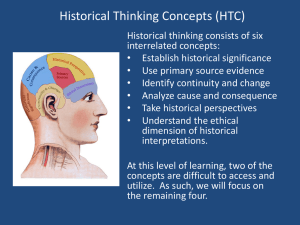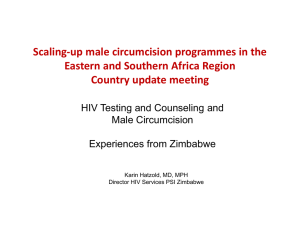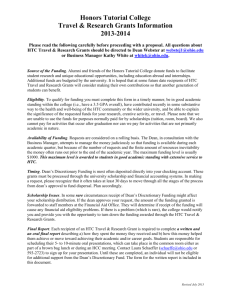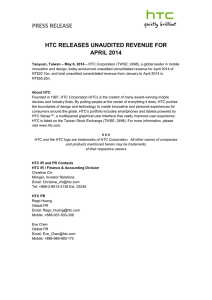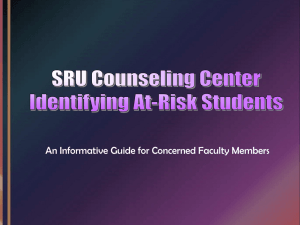testing and counseling module - ClASS Clinical Assessment for
advertisement
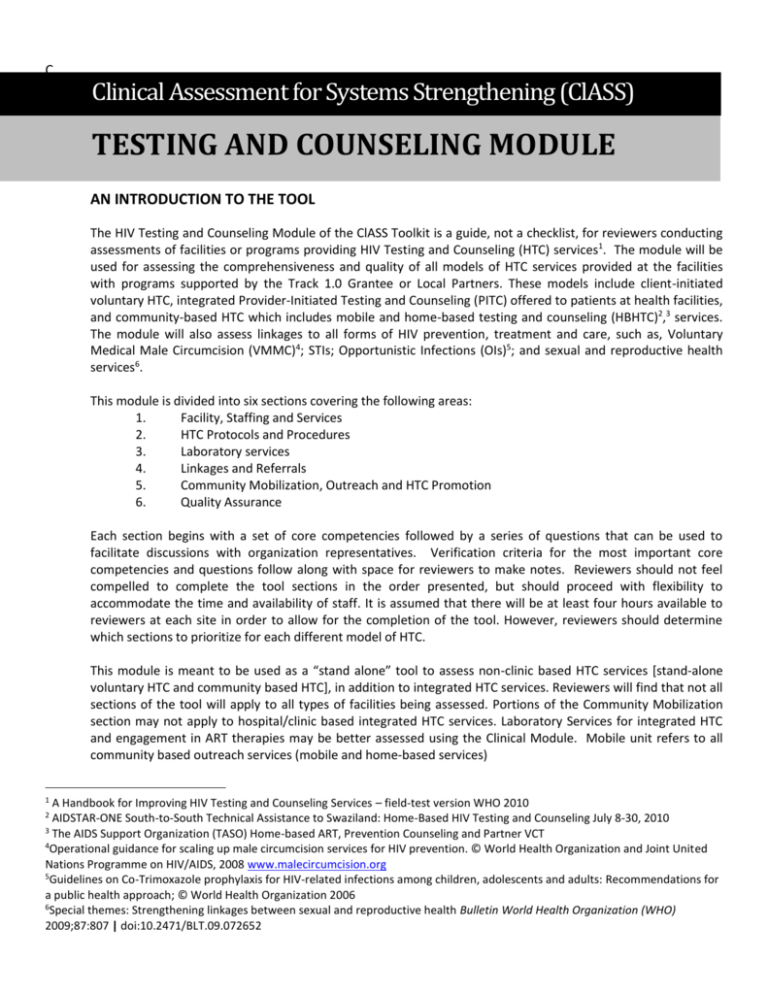
C Clinical Assessment for Systems Strengthening (ClASS) TESTING AND COUNSELING MODULE AN INTRODUCTION TO THE TOOL The HIV Testing and Counseling Module of the ClASS Toolkit is a guide, not a checklist, for reviewers conducting assessments of facilities or programs providing HIV Testing and Counseling (HTC) services1. The module will be used for assessing the comprehensiveness and quality of all models of HTC services provided at the facilities with programs supported by the Track 1.0 Grantee or Local Partners. These models include client-initiated voluntary HTC, integrated Provider-Initiated Testing and Counseling (PITC) offered to patients at health facilities, and community-based HTC which includes mobile and home-based testing and counseling (HBHTC)2,3 services. The module will also assess linkages to all forms of HIV prevention, treatment and care, such as, Voluntary Medical Male Circumcision (VMMC)4; STIs; Opportunistic Infections (OIs)5; and sexual and reproductive health services6. This module is divided into six sections covering the following areas: 1. Facility, Staffing and Services 2. HTC Protocols and Procedures 3. Laboratory services 4. Linkages and Referrals 5. Community Mobilization, Outreach and HTC Promotion 6. Quality Assurance Each section begins with a set of core competencies followed by a series of questions that can be used to facilitate discussions with organization representatives. Verification criteria for the most important core competencies and questions follow along with space for reviewers to make notes. Reviewers should not feel compelled to complete the tool sections in the order presented, but should proceed with flexibility to accommodate the time and availability of staff. It is assumed that there will be at least four hours available to reviewers at each site in order to allow for the completion of the tool. However, reviewers should determine which sections to prioritize for each different model of HTC. This module is meant to be used as a “stand alone” tool to assess non-clinic based HTC services [stand-alone voluntary HTC and community based HTC], in addition to integrated HTC services. Reviewers will find that not all sections of the tool will apply to all types of facilities being assessed. Portions of the Community Mobilization section may not apply to hospital/clinic based integrated HTC services. Laboratory Services for integrated HTC and engagement in ART therapies may be better assessed using the Clinical Module. Mobile unit refers to all community based outreach services (mobile and home-based services) 1 A Handbook for Improving HIV Testing and Counseling Services – field-test version WHO 2010 AIDSTAR-ONE South-to-South Technical Assistance to Swaziland: Home-Based HIV Testing and Counseling July 8-30, 2010 3 The AIDS Support Organization (TASO) Home-based ART, Prevention Counseling and Partner VCT 4 Operational guidance for scaling up male circumcision services for HIV prevention. © World Health Organization and Joint United Nations Programme on HIV/AIDS, 2008 www.malecircumcision.org 5 Guidelines on Co-Trimoxazole prophylaxis for HIV-related infections among children, adolescents and adults: Recommendations for a public health approach; © World Health Organization 2006 6 Special themes: Strengthening linkages between sexual and reproductive health Bulletin World Health Organization (WHO) 2009;87:807 | doi:10.2471/BLT.09.072652 2 CLINICAL ASSESSMENT FOR SYSTEMS STRENGTHENING ClASS Testing and Counseling Module REVIEWER: _________________________ DATE: _______________ SITE: ____________________________________________________ SECTION 1: FACILITY STAFFING AND SERVICES Note: This should be assessed for non-hospital-based HTC services such as stand-alone and community-based HTC, to include mobile & home-based HTC with limited facilities. Integrated/Hospital-based HTC services are covered by the Clinical Module. Core Competencies The facility provides one or more of the following services: integrated PITC, stand-alone HTC, and communitybased service (mobile or HBHTC) outreach services. The facility provides services for all populations (adults, children and adolescents, couples maternal/infant PMTCT and other key populations like MSM and commercial sex workers). Staff qualifications & training (lay and professional) meets national standards and consistently meet client needs. Hours of operation, services and space consistently meet client needs and the overall demand for services. Questions What HTC services are provided to client by the facility or through community-based outreach services? Do the services provided meet the needs of target population groups, including most at risk populations? Does the facility provide comprehensive7 HIV prevention services on site or through referrals? Do the staff qualifications and trainings meet national standards? Do service hours and space meet the client and program needs? 1. 2. 3. Performance Criteria One or more of the following HIV testing and counseling services are provided Verification Information a. Integrated PITC (including PMTCT) b. Stand-alone voluntary HTC c. Community-based outreach HTC services (mobile or home-based HTC ) a. Adults b. Couples-HTC Relevant target c. Children and Adolescents populations receive services either on site or by d. Maternal/infant (PMTCT) e. At risk populations including: MSM, referral SW, PWID, migration population, prisoners a. HIV risk reduction counseling b. HIV rapid testing, if feasible c. Condoms d. VMMC Comprehensive HIV e. Sexual and reproductive health prevention services are f. PEP provided either on site or g. TB screening or referral for TB by referral screening & treatment h. STI screening or referral for STI screening and Treatment i. Assessment for ART initiation or referral for such ClASS Testing and Counseling Module| Version 1.1 | January 2013 Comments Page 1 j. 4. 5. 6. 7. Staff qualifications and training meet standard national guidelines for both HTC and HBHTC Staff turn-over is minimal Service meets client and program needs Services are easily accessible to clients & service hours are convenient to clients Management of OIs k. Laboratory and other diagnostic services or referral for such (CD4, VL, HIV test confirmatory tests l. Support groups for both HIV+ and high-risk HIV- persons a. Staff (lay and professional) are trained and certified in HTC and where relevant, in Home Based HTC methods and skills Child and adolescent counseling Couple counseling PMTCT Counseling for ART Counseling for VMMC Sexual and reproductive health counseling b. Staff are certified by the National reference Laboratory (NRL) in HIV rapid testing techniques and QA methods c. Facility is adequately staffed to meet client demand a. Facility is adequately staffed to meet client demand a. Service days and hours are displayed in full view and in appropriate languages b. Facility or mobile unit is clean c. Facility or mobile unit provides confidentiality for interactions with clients and among staff d. Facility or mobile unit has designated client waiting area with reinforcing educational materials and risk reduction items (such as condoms) available e. Reliable transport is available for mobile and HBHTC teams f. Clients are involved in periodic evaluations of HTC and program improvement activities a. Visit days and hours are convenient for clients (community-based services) b. Evening and/or weekend services are provided c. Services are free; if there is a service fee, it is affordable and can be waived for clients who cannot afford such. ClASS Testing and Counseling Module| Version 1.1 | January 2013 Page 2 d. Service is easily accessible by public transportation, and/or mobile unit is stationed at easily accessible location e. Clients travel less than 10km to access facility or service f. The cultural environment of service delivery site(s) is matched with the local community and target population(s) for services Notes: SECTION 2: HIV TESTING AND COUNSELING PROTOCOLS AND PROCEDURES Core Competencies Providers have access to relevant Protocols and Guidelines (HTC, HBHCT, QA/QC. PEP). Protocols adhere to both national and international HTC standards. Questions What HTC protocols and guidelines do providers access to ensure quality service provision? Has the service adopted rapid HIV testing with same-day results? Does the HTC algorithm meet the national guidelines and international standard requirements? Does the service have clear HIV prevention protocols for HIV-negative client? Performance Criteria Verification Information Comments a. 1. HTC protocols and guidelines are available and used HTC Standard Operating Procedures (SOPs) and protocols are displayed in the facility or mobile unit b. Staff show knowledge of SOPs and Protocols and use it a. 2. Providers adhere to PEP protocols Counselors have and use the Homebased HTC protocol in the field PEP protocol is available PEP kits are available at all times at facility or mobile unit ClASS Testing and Counseling Module| Version 1.1 | January 2013 Page 3 Staff are trained and aware of PEP policies and procedures Use of PEP protocols is documented and reported to supervisors 3. Facility conducts rapid HIV testing, if feasible 4. A standard national HTC algorithm is used 5. Facility provides intervention for HIVnegative clients Same-day HIV test results are provided when feasible a. Staff adhere to the national HTC algorithm b. Facility uses approved HIV testing technologies a. HIV-negative clients are given risk reduction counseling on: Condom use Partner reduction VMCC Sexual and reproductive health Shifting of behavior to lower-risk activities (not sharing needles, nonpenetrative sex, etc.) H IV- clients with high risk profiles are referred and linked to other available risk reduction services in the community or region. Notes: ClASS Testing and Counseling Module| Version 1.1 | January 2013 Page 4 SECTION 3: LABORATORY SERVICES Note: This section is designed for non-hospital-based HTC services (stand-alone and community-based HTC [mobile & home-based]) with limited facilities. Integrated/Hospital-based HTC services are covered by the Clinical Module. Infection control for non-hospital based services is included in this section. Core Competencies Staff skills and expertise consistently meet client need. Facility or mobile unit equipped with adequate lab/testing space, storage, equipment and reagents to meet client needs at all times. HIV tests and appropriate controls are conducted following SOPs onsite. The cold chain for reagents is maintained and monitored at all times on site and/or in mobile units. Staff are trained in basic waste disposal and management procedures. Questions What training and certification procedures are in place for staff? Does the facility or organization providing service have support from a National Reference Laboratory (NRL) for additional diagnostics, quality assurance monitoring and efficient supply system for reagents? What systems are in place to ensure the cold chain for reagents is constantly maintained? What processes exist to ensure quality control and uninterrupted supply chain? What basic infection control (IC) policies are available? What PEP policies are available onsite and in the field for community-based services? Performance Criteria 1. 2. Verification Information a. All staff (lay and professional) have training documentation and Staff are trained and certification in conduct HIV rapid certified in all available testing HIV testing technologies, b. Reliable tests are performed, results especially rapid testing accurately recorded and confidentiality maintained a. Reliable tests are performed, results accurately recorded and Staff perform tests using confidentiality maintained available technologies according to national b. Periodic spot checks are performed standards and protocols Comments to ensure adherence to quality standards 3. Facility or mobile units receive monitoring and support from a NRL & from facility supervisor a. Lab supervisor makes field visits to monitor and support mobile and HBHTC counselors b. Proficiency tests for HIV rapid testing are conducted regularly, i.e. at least twice per year c. Quality assurance procedures for HIV testing are in place (i.e. 10th DBS sample from each counselor sent to NRL for confirmation) ClASS Testing and Counseling Module| Version 1.1 | January 2013 Page 5 d. Facility supervisor provides frequent monitoring of staff (observes HIV testing processes) a. An effective ordering system is in place 4. 5. 6. b. Few episodes of reagent stock-out are experienced c. There is designated secured storage Supplies and reagents are area onsite or offsite (e.g., warehouse, stored securely and an pharmacy, refrigerator, dispensing effective chain supply areas) maintained d. Reagents are stored within the required temperature and humidity ranges e. In the storage facilities, temperature is documented appropriately a. PEP protocol is available b. PEP kits are available at all times at Providers adhere to PEP facility or mobile unit protocols c. Staff are trained and aware of PEP policies and procedures a. There is running water and/or clean water in portable containers in mobile units b. Waste disposal and management protocol is available c. Staff follow universal infection control precautions Staff practice waste d. Staff have relevant protective gear disposal and (gloves, lab coat or aprons, N95 management masks) interventions e. Mobile units and HBHTC counselors are equipped with sharps containers and bags for waste f. Mobile services have Memorandum of Understanding (MoU) with a supporting health facility for waste disposal Notes: ClASS Testing and Counseling Module| Version 1.1 | January 2013 Page 6 SECTION 4: LINKAGE AND REFERRALS Core Competencies The facility adequately and appropriately provides referral services to clients for assessment related to treatment initiation and for other HIV prevention services, follow-up care and support. The facility has documented referral policies that providers use. A functional referral network is in place. Questions What linkage and referral services are provided for HIV- positive clients? Does the service have a referral protocol? What linkage and referral services are provided for HIV-negative clients? What linkage and referral services are provided for clients with sexual and reproductive health needs? What systems are in place to document and track referrals? What formal relationships does the facility or mobile unit maintain with other service networks and how do both HIV infected and uninfected clients obtain those services? Are referral services easily accessible to clients? Performance Criteria a. 1. HTC staff has knowledge of referral services available in the community or region b. c. d. 2. The referral process is standardized and systematic. A referral network is in place Verification Information Prompt linking to an initial medical assessment after post-test counseling (to include assessment for ART initiation, TB screening, STI screening management of Opportunistic Infections, etc.; this may occur on-site if the HTC program is located in a facility that also provides treatment services. Laboratory and other diagnostic services HIV Preventive interventions (VMMC, PMTCT, partner counseling, etc.) Sexual and reproductive health Comments e. Psychosocial support (including support groups) f. Nutrition support g. Home based care (HBC) a. A referral guide is available at the facility or mobile unit b. A standardized referral form is used c. Referrals are recorded and tracked (manually, electronically) d. Facility has documented referral policies e. Attention is paid to the cultural competency of referral sites with regard to target population(s) referred ClASS Testing and Counseling Module| Version 1.1 | January 2013 Page 7 a. Clients are promptly linked to health facilities for medical assessment and treatment after post-test counseling (to include assessment for ART initiation, TB screening, management of Opportunistic Infections , etc.; b. Services are available to clients without delay 3. 4. Referral to follow-up clinical services is easily accessible to clients and occurs smoothly Referral & linkage guidelines are used. c. Clients travel less than 10km to access health facilities d. VMMC services are accessible to clients by public transportation. e. Sexual reproductive health services are accessible to clients by public transportation. f. Staff assist HIV+ client with setting up follow-up medical assessment, if needed. g. Staff alerts medical assessment facility of incoming referral h. Availability of assistance with transportation costs to ensure clients complete referrals a. Verification Information: Referral protocols are displayed in the facility or mobile unit. b. HTC staff use referral protocols Notes: ClASS Testing and Counseling Module| Version 1.1 | January 2013 Page 8 SECTION 5: COMMUNITY MOBILIZATION OUTREACH AND PROMOTION Note: Not applicable to integrated (clinic/hospital based) HCT services Core Competencies The facility or service has established a culturally competent multipronged community mobilization strategy. Mobilization messages educate on the benefits of early HIV detection and access to treatment and care. Mobilization messages are designed to target specific population groups. Questions What strategies are used to raise awareness and encourage access of services? How do facilities ensure delivery of appropriate and engaging messages for targeted groups? Which community partners does the program collaborate with to gain access to most at risk population groups i.e. major employers (mines, farms, tea/coffee plantations), schools, CBOs and Faith Based Organizations (FBOs)? Performance Criteria 1. Verification Information a. Social marketing b. Media Electronic (radio, TV) Print (flyers, pamphlets, posters) c. Target population(s) are involved in developing and evaluating messages The facility uses a and communication strategies culturally competent d. Outreach involves direct community multipronged strategy for engagement by outreach workers reaching and engaging (volunteer and/or professional), ideally target population groups from the target population in HTC services Door-to-door Informal group discussions Community leader involvement Comments e. Has Partnerships with existing CBOs, major employers, schools and FBOs a. When possible, members of target population (s) are involved in delivering mobilization messages b. Messages address HIV transmission, prevention, HTC, treatment and care 2. c. Target populations can see themselves Mobilization messages within messages and strategies clarify facts about HIV, the value of HCT, and HIV d. Messages address HIV-related stigma, prevention, and are prejudice and discrimination delivered in a culturally e. When warranted, messages address competent manner HIV-related gender-based violence (GBV) f. Messages are appropriate for the respective target group (i.e., respectful and not off-putting) g. Messages are in the local language(s) ClASS Testing and Counseling Module| Version 1.1 | January 2013 Page 9 Notes: SECTION 6: QUALITY ASSURANCE/PERFORMANCE MONITORING Core Competencies The facility has a monitoring system of both quality HIV Testing and counseling. The facility has a performance appraisal system for quality of care. Questions What monitoring system is in place to identify performance problems? How is the performance monitoring system documented? What systems are in place to improve staff proficiency? Performance Criteria 1. 2. 3. Verification Information a. Observation of HTC sessions by supervisors b. Periodic client satisfaction surveys or The facility has a process other reviews for assessing staff c. Supervisors review of counselor notes performance and client records d. Regular debriefing sessions by supervisors with staff focusing on quality of service delivery a. Quality assurance forms used to The facility documents record and improve staff performance staff performance b. Quality performance indicators are known by staff and consistently used a. Debriefing sessions (individual and groups sessions) review quality The facility takes performance and shape strategies for measures to improve improvement proficiency b. Re-training is offered when warranted c. SOPs, protocols and quality goals are available and easily accessible to all ClASS Testing and Counseling Module| Version 1.1 | January 2013 Comments Page 10 staff d. Periodic staff training occurs on cultural competency with target population(s) Notes: ClASS Testing and Counseling Module| Version 1.1 | January 2013 Page 11

